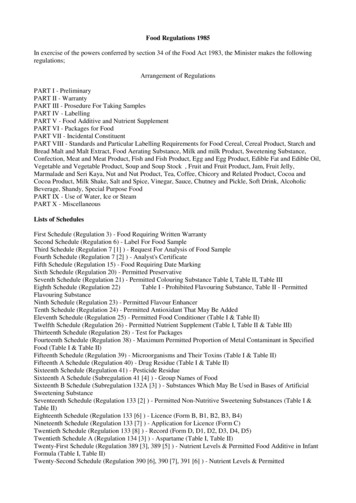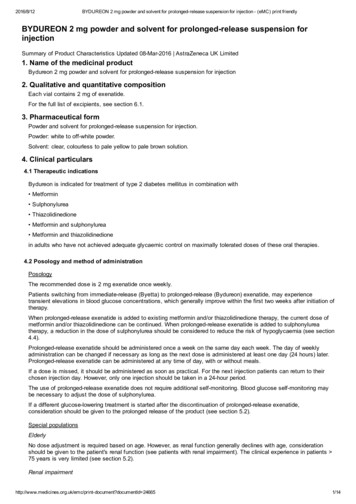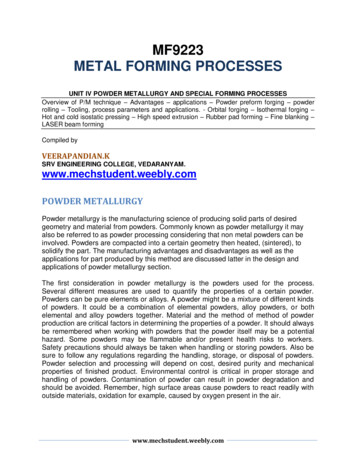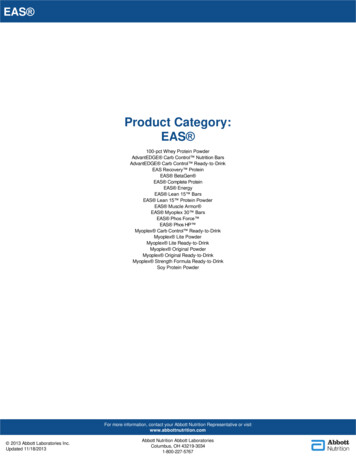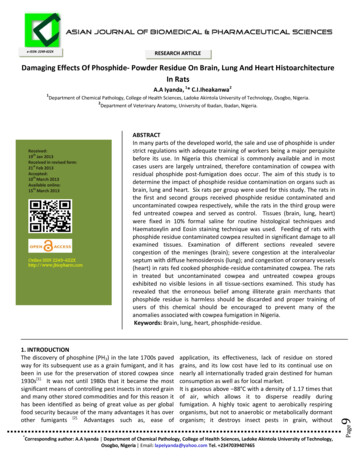
Transcription
e-ISSN: 2249-622XRESEARCH ARTICLEDamaging Effects Of Phosphide- Powder Residue On Brain, Lung And Heart HistoarchitectureIn RatsA.A Iyanda, 1* C.I.Iheakanwa2Department of Chemical Pathology, College of Health Sciences, Ladoke Akintola University of Technology, Osogbo, Nigeria.2Department of Veterinary Anatomy, University of Ibadan, Ibadan, Nigeria.Online ISSN 2249–622Xhttp://www.jbiopharm.com1. INTRODUCTIONThe discovery of phosphine (PH3) in the late 1700s pavedway for its subsequent use as a grain fumigant, and it hasbeen in use for the preservation of stored cowpea since1930s[1]. It was not until 1980s that it became the mostsignificant means of controlling pest insects in stored grainand many other stored commodities and for this reason ithas been identified as being of great value as per globalfood security because of the many advantages it has overother fumigants [2]. Advantages such as, ease of*application, its effectiveness, lack of residue on storedgrains, and its low cost have led to its continual use onnearly all internationally traded grain destined for humanconsumption as well as for local market.It is gaseous above 88 C with a density of 1.17 times thatof air, which allows it to disperse readily duringfumigation. A highly toxic agent to aerobically respiringorganisms, but not to anaerobic or metabolically dormantorganism; it destroys insect pests in grain, withoutCorresponding author: A.A Iyanda Department of Chemical Pathology, College of Health Sciences, Ladoke Akintola University of Technology,Osogbo, Nigeria Email: lapeiyanda@yahoo.com Tel. 23470394074659Received:th19 Jan 2013Received in revised form:st21 Feb 2013Accepted:th10 March 2013Available online:th15 March 2013ABSTRACTIn many parts of the developed world, the sale and use of phosphide is understrict regulations with adequate training of workers being a major perquisitebefore its use. In Nigeria this chemical is commonly available and in mostcases users are largely untrained, therefore contamination of cowpea withresidual phosphide post-fumigation does occur. The aim of this study is todetermine the impact of phosphide residue contamination on organs such asbrain, lung and heart. Six rats per group were used for this study. The rats inthe first and second groups received phosphide residue contaminated anduncontaminated cowpea respectively, while the rats in the third group werefed untreated cowpea and served as control. Tissues (brain, lung, heart)were fixed in 10% formal saline for routine histological techniques andHaematoxylin and Eosin staining technique was used. Feeding of rats withphosphide residue contaminated cowpea resulted in significant damage to allexamined tissues. Examination of different sections revealed severecongestion of the meninges (brain); severe congestion at the interalveolarseptum with diffuse hemosiderosis (lung); and congestion of coronary vessels(heart) in rats fed cooked phosphide-residue contaminated cowpea. The ratsin treated but uncontaminated cowpea and untreated cowpea groupsexhibited no visible lesions in all tissue-sections examined. This study hasrevealed that the erroneous belief among illiterate grain merchants thatphosphide residue is harmless should be discarded and proper training ofusers of this chemical should be encouraged to prevent many of theanomalies associated with cowpea fumigation in Nigeria.Keywords: Brain, lung, heart, phosphide-residue.Page1
A.A Iyanda.: Asian Journal of Biomedical and Pharmaceutical Sciences 3(17) 2013, 9-13Treatment of cowpea:Cowpea was fumigated, using Protex (aluminumphosphide-57% inert ingredients-43%) manufactured byUnited Phosphorus Ltd, India. Using a ratio of 2 tablets ofphosphide per m3 of space, cowpea was fumigated at 29ºC over a period of 48 hours. At the end of the fumigationprocess, the grains were separated from the fumigant, andthe treated cowpea was divided into two, and one partwas deliberately contaminated with phosphide powderresidue, i.e. residue of a quarter tablet of Protex was usedto contaminate one kilogram of cowpea. The rats were fedtheir different cowpea type over a period over 8 hours.The study was terminated exactly 24 hours after itcommenced.Histological study:The female Wistar rats used for this study were sacrificedby cervical dislocation and their skulls opened using boneforceps to expose the brain of the rats after which thebrain quickly dissected and fixed in 10% formal saline forroutine histological techniques as well as sections of lungand heart. The tissues obtained were dehydrated in anascending grade of alcohol (ethanol), cleared in xylene andembedded in paraffin wax. A series of sections of 7microns thick were obtained using a rotatory microtome.These were deparaffinized and stained routinely withHaematoxylin and Eosin. Magnification was at x 400.103. RESULTS AND DISCUSSION:The results of this study are presented in Figures 1-3.Pageaffecting grain viability[3]. Due to its high degree of toxicity,in the UK aluminum phosphide (AlP) is available in form oftablets or pellets (Phostoxin, Talunex, and Degesch) andthe supply is restricted under the Pesticides Act 1998 toqualified users[4]. While there is restriction in the use ofphosphide in the developed world, in Nigeria and manyparts of the developing world, there is ease of availabilityof this chemical. Exposure of phosphide to moistureresults in the release of phosphine gas, which can beabsorbed rapidly by inhalation as well as through dermaland gastrointestinal routes.Dua et al.[5] have revealed that the brain and liver are twoof the most susceptible tissues to phosphide toxicity, andan earlier study in which phosphide powder residuecontaminated cowpea was fed to rats, revealed significantalterations in serum levels of hepatic indices. This presentstudy is designed to investigate if such treatment has anyeffect on the morphology of the brain cells, so as todetermine the extent of tissue damage which can resultfrom poor handling of the grain-fumigation process. Asurvey of the local market has revealed that extendedfumigation period, use of abnormally high phosphidecontent in relation to quantity of grain and phosphidepowder residue contamination of cowpea, are some of thecommon ways in which cowpea consumers are exposed totoxic effects of this agent, and information abound tosuggests that consumption of such cowpea have resultedin a myriad of medical complaints. The aim of this study isto identify the impact of phosphide powder residue onbrain, lung and heart sections, since the brain cells arehighly oxidative cells and unspent phosphide has beenrecognized to alter the oxidative phosphorylativepathway.2. MATERIALS AND METHODS:Animals and animal care: Eighteen female albino rats (250g) were obtained from the Animal House of theDepartment of Veterinary Physiology, University ofIbadan, Nigeria where the study also took place. Theanimals were kept in cages at ambient temperature of23 3 C and a 12 h light, 12 h dark cycle and were fed withstandard laboratory diet and given water ad libitum. Therats were divided equally into 3 groups; the rats in 1st and2nd groups were fed with cooked phosphide treatedcowpea, but cowpea of the 2nd group was deliberatelycontaminated with phosphide-powder residue. The 3rdgroup served as the control and given untreated cowpea.This study was carried out in conformity with national andinternational laws and Guidelines for Care and Use ofLaboratory Animals in Biomedical Research; aspromulgated and adopted by United States Institutes ofHealth (1985). Asian Journal of Biomedical and Pharmaceutical Sciences, all rights reserved.Volume 3, Issue 17, 2013
Asian Journal of Biomedical and Pharmaceutical Sciences, all rights reserved.Volume 3, Issue 17, 2013PageAluminum phosphide (ALP), a highly toxic pesticide, is amitochondrial toxin that causes death by cardiac andmetabolic toxicity. Siddaiah et al[6] have recognized thatthis chemical’s ominous effect is cardiac toxicity, whichmay range from minor electrocardiographic abnormalitiesto severe depression of cardiac contractility secondary totoxic myocarditis. This study also confirmed significantabnormalities in the sections of the heart and lung asrevealed by histology results. Anger et al.[7] have alsoidentified that microscopic examination revealedcongestion of all the viscera organs studied and obviousasphyxia lesions in the pulmonary parenchyma.The effects phosphide residue contaminated cowpea onanimals has not been widely explored, since in most casesit is taken for granted that the fumigation process will becarried out according to the manufacturer’s instructionbut our market survey revealed a number of lapsesassociated with cowpea fumigation process in Nigeria.Among other anomalies, prolonged fumigation period andphosphide residue contamination of cowpea may be likelycauses of many of the complaints commonly associatedwith cowpea consumption. That such anomaly may resultin pathology of the brain may be assumed from the pastfindings in which, when experimental animals wereexposed to phosphine gas, the active derivative ofphosphide, abnormal brain presentations were reported.The work of Dua et al.[8] have established that inhibition ofcytochrome oxidase causes decline oxygen uptake anddecreased ATP synthesis which eventually resulted incellular energy crisis and may trigger non-oxidativeglucose break down, thereby leading to a significantdecrease in plasma glucose levels in the ALP treated rats.The decrease in ATP generation which occurs along withhypoglycemia may further intensify the cellular energydeficits. These alterations were more pronounced in brainand liver cells than other tissues according to their study.Moreover, according to them the brain tissue especially inorder to meet the sudden increase in the local energydemand, utilizes its stored energy in the form of glycogenbreakdown as observed by a decrease in the glycogenlevels in the brain cells which was accompanied by amarked increase in the activity of glycogen phosphorylase.That this residue may have a profound effect on the braincan be postulated through another observation made bythese workers, they showed that the glycolytic rate waselevated in brain tissue subsequent to phosphideexposure and this was evident by significant increase inthe activities of hexokinase and phosphofructokinaseenzymes, while the liver (another susceptible organ)exhibited a decrease in activities of these enzymes in ALPtreated rats. The results of their study thereforesuggested that ALP caused cellular energy deficit whichcompromised energy status of the brain as well as inducedsubstantial alterations in glucose homeostasis. However,the activity of glucose-6-phosphate dehydrogenase, animportant enzyme in the pento-phosphate pathway wassignificantly decreased in both tissues. These alterationsmay be the perquisite for many of the histologic distortionin the cellular architecture of the brain of animals whichwere fed with phosphide residue contaminated cowpea.In addition, results of brain histology of treated rats thatshowed congestion of the meninges probably furthersuggests that phosphide residue contamination of cowpeamay have harmful effect on exposed animals. This is notsurprising because a number of pesticides used inagriculture, designed to protect crops against unwantedspecies, such as weeds, insects, and fungus are knownneurotoxic agents. These are pesticides such bisdithiocarbamates, and chlorophenoxy whichare currently in use, not only in Europe and some otherdeveloped parts of the world but in Africa as well. Theyhave been found to cause neurodevelopmental toxicity[9].Moreover, because brain biochemistry of many animalspecies is identical such pesticides may also be neurotoxicto humans, and there are indications to suggest that thedeveloping brain may be more vulnerable to adverseeffects of this pesticide than adult brain. This is because inthe course of prenatal life, the human brain must developfrom the ectodermal cells of the embryo into a complexorgan consisting of billions of precisely located, highlyinterconnected, and specialised cells. For maximal braindevelopment, neurons must move along precise pathwaysfrom their points of origin to their assigned locations aswell as connect with other cells, to facilitate vitalcommunication among the cells[10-12]. These are processesthat must occur within a tightly controlled time frame,such that each developmental stage has to be reached onschedule and in the correct sequence, since there is littlepotential for later repair, and the consequences maytherefore be permanent[10-12]. Cowpea is consumed bydifferent categories of human subjects in manycommunities in Africa; it is sometimes used to weanbabies and this is one of the reasons why unspentphosphide residue should be prevented from mixing withgrains.That phosphide residue contaminated cowpea is capableof causing such toxic effect to the brain cells may be11A.A Iyanda.: Asian Journal of Biomedical and Pharmaceutical Sciences 3(17) 2013, 9-13
and lung were analyzed for glutathione (GSH) levels andlipid peroxidation (as malondialdehyde and 4hydroxyalkenals) and brain and lung for 8hydroxydeoxyguanosine (8-OH-dGuo) in DNA. Phosphidecaused a significant decrease in GSH concentration andelevation in lipid peroxidation in not only the brain (3642%), but also in lung (32-38%) and liver (19-25%). Theabnormal lung presentation (severe congestion at theinteralveolar septum, with diffuse hemosiderosis) in ratsin the contaminated group may be as a result of combinedtoxic effect of phosphide (oxidative stress and cytochromec oxidase)Many of the common neurological changes like ataxia,stupor, tremors and convulsions have been observedfollowing aluminum phosphide poisoning. Acute hypoxicencephalopathy has also been linked with exposure toaluminum phosphide, which may proceed to death as aresult of complete depression of the central nervoussystem and paralysis of the respiratory centers of thebrain[21]. Muscarinic effect which commonly present asdiarrhea[22], which has also been reported for carbamateinsecticides, though absent in these rats is one of the mostcommon complaints in human subjects in Nigeria postcowpea consumption.To further support the possible occurrence of brainabnormality in consumers of phosphide powder residuecontaminated cowpea is the fact that there are reports toconfirm that many of the workers who handle thefumigation process, who are exposed to various degreesof phosphide (phosphine), had manifested one or moreneuropsychiatric symptoms such as anxiety, impotenceand easy fatigue. With about 50% of the subjects(workers) recruited for the study showing hyperreflexia,polyneuropathy, lumbar radiculopathy, and cervicalmyelopathy, as well as anxious mood, impaired attention,and psychomotor stimulation. In addition, EEG recordingsshowed abnormal findings in 17.4% of the subjects, andthis was mainly observed with longer exposure[23], thistherefore suggests that many of the histologicpresentations observed in the rats exposed to phosphidepowder residue may also present in human subjects whoconsume phosphide powder residue contaminatedcowpea.In conclusion, the effects of phosphide residue onimportant organs of the body are not diminished fromthose that have been earlier observed through the use ofaluminum phosphide itself. This study shows that theerroneous belief among illiterate grain merchants thatunspent phosphide residue may be harmless should bediscarded and unintentional phosphide residuecontamination of cowpea should be guarded against. Asian Journal of Biomedical and Pharmaceutical Sciences, all rights reserved.Pagebuttressed by the effect of phosphine gas (derived fromphosphides), Nath et al.[3] have identified that there mightbe neural/behavioural aspects of phosphine toxicity. Inaddition, phosphine gas has been linked with enhancedacetylcholine neurotransmission, this it does bysuppressing acetylcholine esterase[13,14]. The toxic effectsof many other pesticides have been established to affectthe brain, for example the primary target oforganophosphate (OP) insecticides is the enzymeacetylcholinesterase (AChE), which hydrolyses theneurotransmitter acetylcholine in not only the peripheralbut also in the central nervous system. Organophosphatescontaining a P O moiety are effective inhibitors of AChE,inhibition of AChE leads to accumulation of acetylcholineat cholinergic synapses, thereby causing over-stimulationof muscarinic and nicotinic receptors. This is a molecule(acetylcholine) that plays important role in braindevelopment; acetylcholine and other neurotransmittersplay unique trophic roles in the development of theCNS[15], it may then be inferred that inhibition of AChE andthe resulting accumulation of acetylcholine may disturbthis developmental processes. Many of the features of"cholinergic syndrome" associated with this pesticideswhich are headache, drowsiness, dizziness, confusion,blurred vision, slurred speech, ataxia, coma, convulsionsand block of respiratory centre[16] can also be linked withthese morphological alterations observed in the brainhistology of phosphide residue treated rats, an indicationthat a small amount of phosphide remains in the residue.This may be the reason why manufacturers of phosphidealways discourage grain contamination by phosphideresidue. That the abnormality in neurotransmitteracetylcholine may be involved in abnormal/morphologicchanges in the brain cells may be evident from ourfindings in which congestion of the meninges wasobserved in treated rats, many abnormal brainpresentations have been linked with lack of hydrolysis ofacetylcholine.Although many of these morphologic changes may belinked to inhibition of cytochrome c oxidase, of themitochondrial electron transport chain, which is believedto be the primary site of action for phosphine[17-19]. Theinvolvement of free radical generation cannot bediscounted since 50% inhibition of cytochrome c oxidase issufficient for generation of superoxide anions[19] have alsobuttressed this, indicating that increased lipidperoxidation in rat brain is always associated withaluminum phosphide ingestion. The study of Hsu et al. [20],was focused on phosphide-induced oxidative damage inrats and antioxidants as candidate protective agentsrevealed that when male Wistar rats were treated ip withphosphide at 2 mg/kg and thirty min later the brain, liver,12A.A Iyanda.: Asian Journal of Biomedical and Pharmaceutical Sciences 3(17) 2013, 9-13Volume 3, Issue 17, 2013
A.A Iyanda.: Asian Journal of Biomedical and Pharmaceutical Sciences 3(17) 2013, ck E. The chemistry of phosphine. Fortschritte derChemischen Forschung. 1973;35:1–64.Chaudhry MQ. A review of the mechanisms involved in theaction of phosphine as an insecticide and phosphineresistance in stored-product insects. Pesticide Science.1997;49(3):213–228.Nath NS, Bhattacharya I, Tuck AG, Schlipalius DI, Ebert PR.Mechanisms of Phosphine Toxicity. J Toxicol. 2011;2011:494168.Bogle RG, Theron P, Brooks P, Dargan PI, Redhead J.Aluminium phosphide poisoning. Emerg Med J. 2006 January;23(1): e3.Dua R, Sunkaria A, Kumar V, Gill KD. Impaired mitochondrialenergy metabolism and kinetic properties of cytochromeoxidase following acute aluminium phosphide exposure in ratliver. Food and Chemical Toxicology. 2010;48(1):53–60.Siddaiah L, Adhyapak S, Jaydev S, Shetty G, Varghese K, PatilC, Iyengar S. Intra-aortic balloon pump in toxic myocarditisdue to aluminum phosphide poisoning. J Med Toxicol. 2009Jun;5(2):80-3.Anger F, Paysant F, Brousse F, Le Normand I, Develay P,Gaillard Y, Baert A, Le Gueut MA, Pepin G, Anger JP. Fatalaluminum phosphide poisoning. J Anal Toxicol. 2000;24(2):902.Dua R, Kumar V, Sunkaria A, Gill KD. Altered glucosehomeostasis in response to aluminium phosphide inducedcellular oxygen deficit in rat. Ind J Exper Biol. 2010;48(7):722–730.Bjørling-Poulsen M, Andersen HR, Grandjean P. Potentialdevelopmental neurotoxicity of pesticides used in Europe.Environ Health 2008, 7:50.Dobbing J. Vulnerable periods in developing brain. In AppliedNeurochemistry. Edited by Davison AN, Dobbing J.Philadelphia: Davis; 1968:287-316.Rodier PM. Developing brain as a target of toxicity. EnvironHealth Perspect 1995;103(Suppl 6):73-76.Rice D, Barone S Jr. Critical periods of vulnerability for thedeveloping nervous system: evidence from humans andanimal models.Al-Azzawi M, Al-Hakkak Z, Al-Adhami B. In vitro inhibitoryeffects of phosphine on human and mouse serumcholinesterase. Toxicol & Environ Chem. 1990;29(1):53–56.Potter WT, Garry VF, Kelly JT, Tarone R, Griffith J, Nelson RL.Radiometric assay of red cell and plasma cholinesterase inpesticide appliers from Minnesota. Toxicol Appl Pharmacol.1993;119(1):150–155.Whitaker-Azmitia PM. Role of serotonin and otherneurotransmitter receptors in brain development: basis fordevelopmental pharmacology. Pharmacol Rev. 1991;43:553561.Lotti M. Clinical Toxicology of Anticholinesterase Agents inHumans. In Handbook of Pesticide Toxicology. Volume 2. 2ndedition. Edited by Krieger RI. San Diego: Academic Press;2001:1043-1085.Dua R, Gill KD. Effect of aluminium phosphide exposure onkinetic properties of cytochrome oxidase and mitochondrialenergy metabolism in rat brain. Biochim Biophys Acta2004;1674:4-11.Bolter CJ, Chefurka W. Extramitochondrial release ofhydrogen peroxide from insect and mouse liver mitochondriausing the respiratory inhibitors phosphine, myxothiazol, andantimycin and spectral analysis of inhibited cytochromes.Arch Biochem Biophys. 1990;278:65-72.19. Price NR, Dance SJ. Some biochemical aspects of phosphineaction and resistance in three species of stored productbeetles. Comp Biochem Physiol. C 1983;76:277-281.20. Hsu C, Han B, Liu M, Yeh C, Casida JE. Phosphine-inducedoxidative damage in rats: attenuation by melatonin. FreeRadic Biol Med. 2000 Feb 15;28(4):636-42.21. Dua R, Gill KD. Aluminium phosphide exposure: implicationson rat brain lipid peroxidation and antioxidant defencesystem. Pharmacol Toxicol. 2001;89(6):315–319.22. Lifshitz M, Shahak E, Bolotin A, Sofer S. Carbamate poisoningin early childhood and in adults. J Toxicol Clin Toxicol.1997;35:25-27.23. Amr MM, Abbas EZ, El-Samra M, El BM, Osman AM.Neuropsychiatric syndromes and occupational exposure tozinc phosphide in Egypt. Environ Res. 1997;73:200-206. Asian Journal of Biomedical and Pharmaceutical Sciences, all rights reserved.131.Page4. REFERENCESVolume 3, Issue 17, 2013
revealed that the erroneous belief among illiterate grain merchants that phosphide residue is harmless should be discarded and proper training of users of this chemical should be encouraged to prevent many of the anomalies associated with cowpea fumigation in Nigeria. Keywords:



